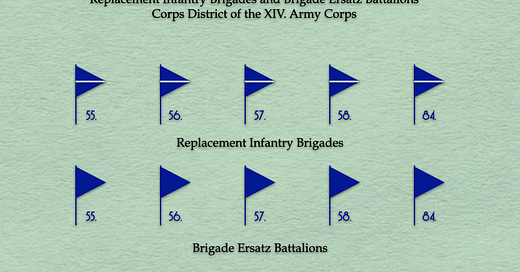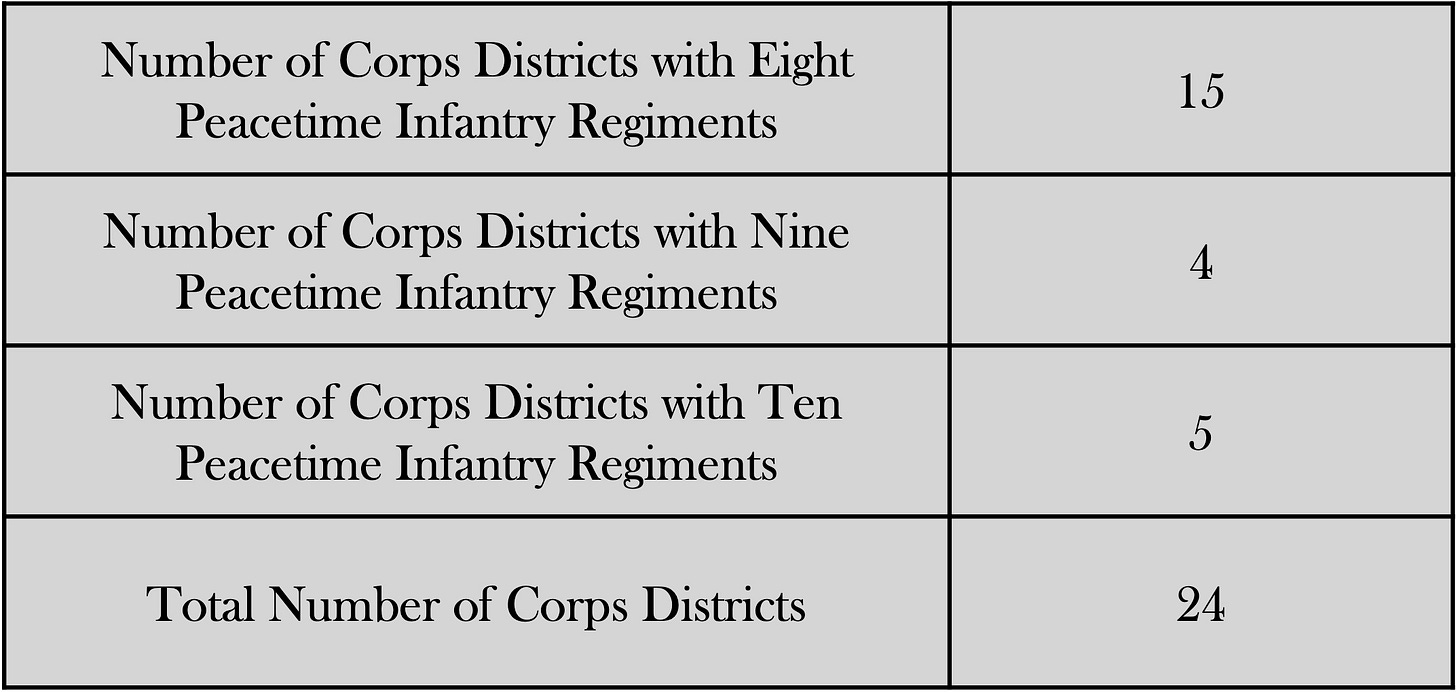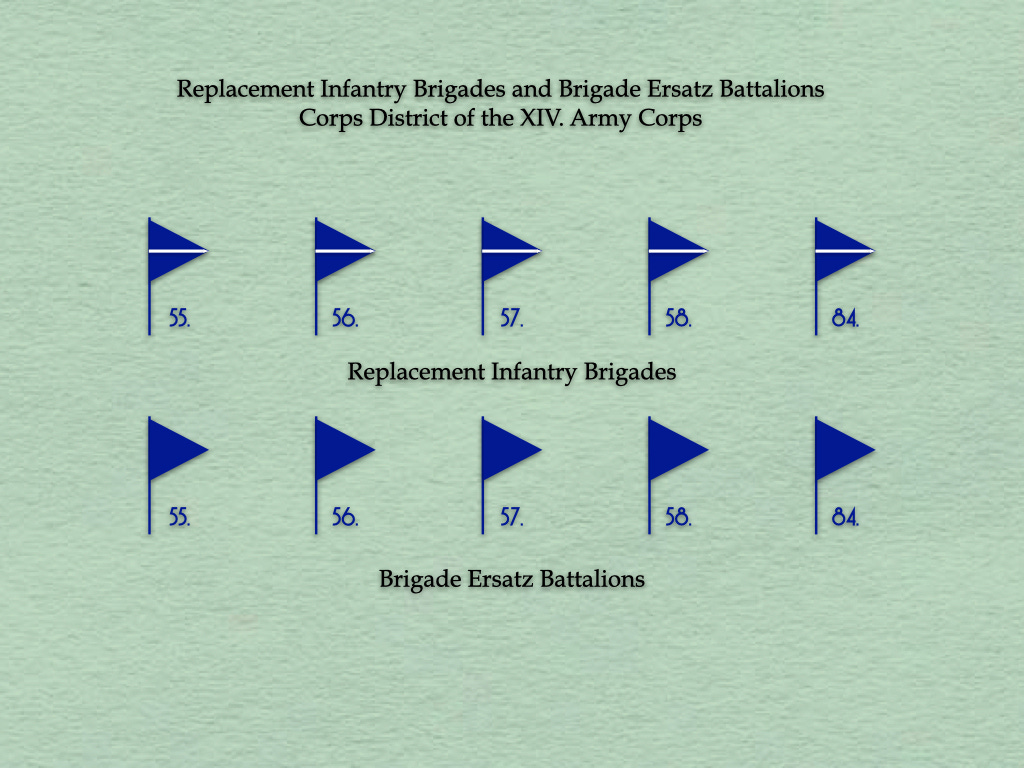In 1914, the territory of the German Empire was divided into twenty-four army corps districts [Korpsbezirke.] Before the outbreak of the war in August, each of these was home to two infantry divisions, two cavalry brigades, a regiment of heavy artillery [Fußartillerie], a battalion of pioneers, and a train battalion. Each corps district also accommodated a number of other units which varied, in both type and number, from one corps district to another.
Upon mobilization, the peacetime units filled out their ranks with reservists, hitched their wagons to requisitioned horses, and marched off to war. Most, but not all, of these units came together to form an active army corps, which bore the same name, and carried the traditions, of its peacetime predecessor. Before taking to the field, however, the headquarters of the peacetime army corps [Generalkommando] split into two unequal parts. One of these became the headquarters of the aforementioned army corps, the other the staff of the corps district [Stellvertretende Generalkommando]. The lopsided splitting of peacetime organizations also occurred at lower echelons. Thus, when the headquarters of each peacetime infantry brigade embarked on active service, it left behind a “replacement infantry brigade” [Stellvertretende Infanterie Brigade].
When the division of peacetime command structures took place, each corps district became, among many other things, a workshop for the creation of new units. How this worked in the first few weeks of the war can be seen in the example of the infantry units formed by the district of the XIV. Army Corps.
Composed mostly of units belonging to the contingent of the Grand Duchy of Baden, the peacetime XIV. Army Corps was a little larger than the typical army corps of the German Empire. Where most army corps had eight infantry regiments, it had ten such units. This meant that, thanks to the possession of additional barracks, training grounds, and reservists, it would be able to create more wartime infantry units than most of its counterparts.
On the second day of mobilization (3 August 1914), each of the ten infantry regiments of the XIV. Army Corps formed an Ersatz battalion. Each of these would provide a home for fit men not yet needed by the regiment, men who had yet to complete their training, men who were healing from wounds, and men who had been judged unsuited to the rigors of life in the field.
In the days that followed, the district of the XIV. Army Corps formed seven units designed for active service: four Reserve infantry regiments and three Landwehr regiments. Once this was done, they formed five units, also fated for service in the field, with the curious name of “brigade Ersatz battalions” [Brigade Ersatz Bataillonen].
While not quite as young (and thus, recently trained) as the reservists assigned active infantry regiments, the men who joined the Reserve infantry regiments were nonetheless fit enough to do a great deal of hard marching. Those assigned to the Landwehr infantry regiments were, as a rule, older (and thus, ipso facto, more distant from peacetime military service) than those of reserve infantry regiments.
The men of the brigade Ersatz battalions were those who, for one reason or another, had failed to find a place in the ranks of active, Reserve, or Landwehr regiments. The most celebrated of these were subjects of the German Empire who had been living overseas when war broke out. On the whole, however, the reservists who ended up in brigade Ersatz battalions were simply surplus to the needs of the regiments filled out or formed during the first week of mobilization.
The use of the terms “brigade” and “Ersatz” in the names of the brigade Ersatz battalions serves as a reminder of the way such units were formed. First, the Ersatz battalions of each infantry regiment formed a detachment of two infantry companies. Each of these reported, two-by-two, to a replacement infantry brigade, which used them to form four-company battalions, each of which bore the same number as its parent replacement infantry brigade.
Because it had been so richly supplied with peacetime infantry regiments, the corps district of the XIV. Army Corps possessed five replacement infantry brigades. This, in turn, meant that it was capable of forming five brigade Ersatz battalions. (Most other army corps districts produced but four brigade Ersatz battalions.)
Sources: Rudolf von Freydorf, Das 1. Badische Leib-Grenadier-Regiment Nr. 109 im Weltkrieg 1914-1918, (Oldenburg: Gerhard Stalling, 1927) and Georg Engelbert Graf, Das Württembergische Infanterie-Regiment Nr. 478 und seine Stammtruppen: Brigade-Ersatz-Bataillone Nr. 51, 52, 53 und Ersatz-Infanterie-Regiment Nr. 51 (Stuttgart: Belser, 1924)






